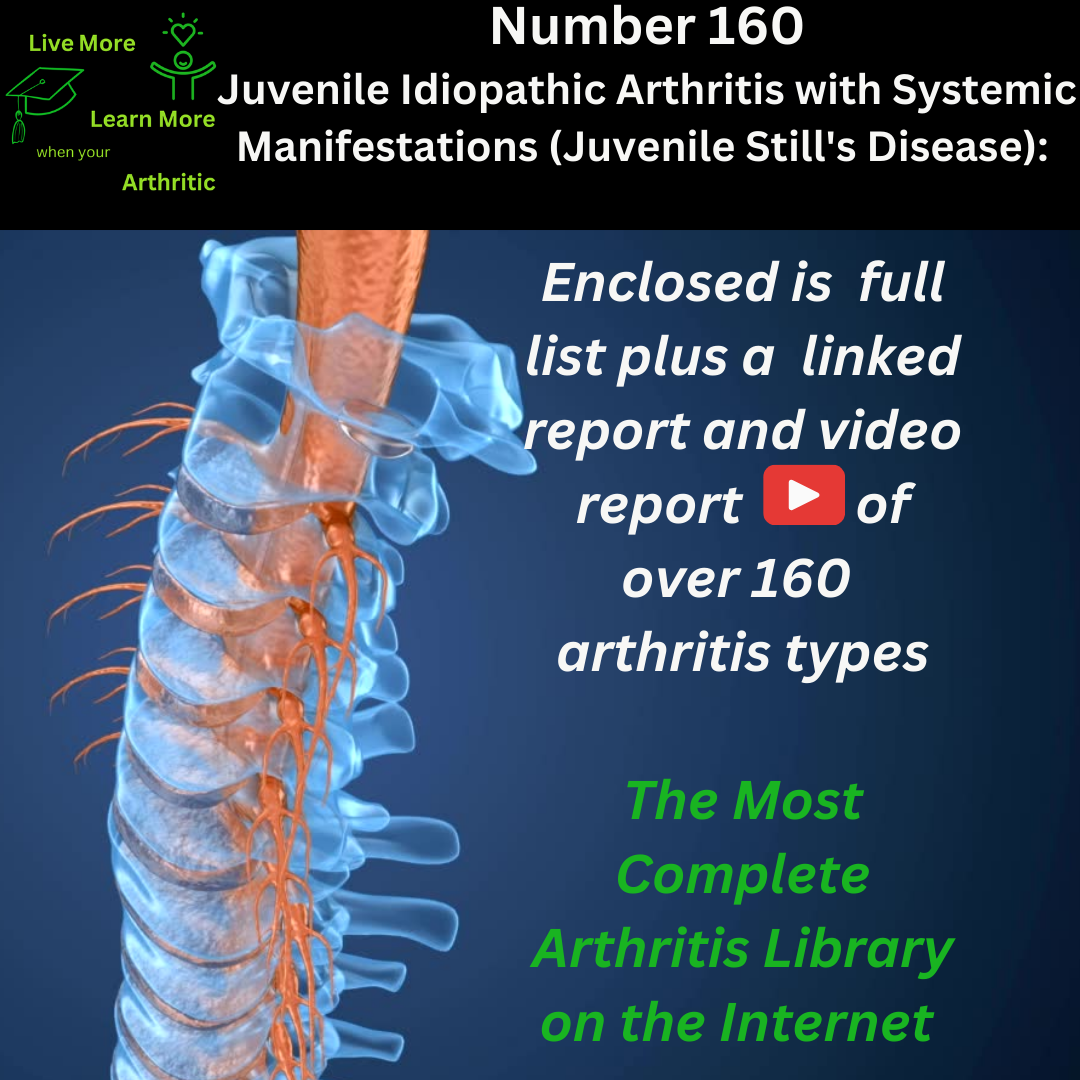
Juvenile Idiopathic Arthritis with Systemic Manifestations (Juvenile Still’s Disease): Number 160 Type of Arthritis
Juvenile Idiopathic Arthritis with Systemic Manifestations (Juvenile Still’s Disease)
Juvenile Idiopathic Arthritis (JIA) with systemic manifestations, also known as Juvenile Still’s disease, is a rare type of childhood arthritis characterized by systemic inflammation and multi-system involvement. Let’s delve into the complexities of this condition and its impact on overall health.
 Overlapping Arthritis Conditions
Overlapping Arthritis Conditions
Juvenile Still’s disease can overlap with other forms of inflammatory arthritis, such as adult-onset Still’s disease (AOSD) and systemic lupus erythematosus (SLE), due to shared systemic features and autoimmune mechanisms.
Inflammatory Nature of JIA
Juvenile Still’s disease is classified as an inflammatory arthritis because it involves systemic inflammation affecting multiple organs and tissues, including joints, skin, and internal organs. The immune system mistakenly attacks healthy tissues, leading to inflammation and tissue damage.
Affected Body Parts and Symptoms
The most commonly affected body parts in Juvenile Still’s disease include joints (especially knees, wrists, and ankles), skin (rash), lymph nodes, and internal organs (heart, liver, spleen). Symptoms may include high fever, rash, joint pain, swelling, and fatigue. Limited range of motion can occur due to joint inflammation and damage.
Causes, Triggers, and Onset
The exact cause of Juvenile Still’s disease is unknown, but it is believed to involve genetic predisposition and abnormal immune responses triggered by environmental factors, such as infections. The disease typically manifests in childhood or adolescence.
Autoimmune Nature and Risk Factors
Juvenile Still’s disease is considered an autoimmune disorder, where the immune system mistakenly attacks healthy tissues. Risk factors may include genetic predisposition, environmental triggers, and family history of autoimmune diseases.
Complications and Health Risks
Complications of Juvenile Still’s disease can include joint damage (arthritis), growth disturbances, anemia, pericarditis (inflammation of the heart lining), and amyloidosis (abnormal protein buildup). Chronic inflammation can impact overall health and quality of life.
Achieving a Higher Quality of Life
A proactive approach to managing Juvenile Still’s disease is crucial for achieving a higher quality of life. This includes early diagnosis, aggressive treatment with anti-inflammatory medications disease-modifying antirheumatic drugs, and biologic therapies. Physical therapy and lifestyle modifications can also improve mobility and reduce complications.
Possible Complications
Possible complications of Juvenile Still’s disease include joint deformities, growth delays, cardiovascular complications (e.g., pericarditis), and systemic symptoms affecting various organs. Early intervention and comprehensive care can minimize these risks.
Differences from Primary Arthritis
Juvenile Still’s disease differs from primary arthritis due to its systemic nature, involving not only joints but also systemic inflammation affecting multiple organs. This distinguishes it from more localized forms of arthritis, such as osteoarthritis.
Age of Onset and Gender Differences
Juvenile Still’s disease typically presents in childhood or adolescence, with peak onset between ages 2 and 4 and another peak between ages 8 and 12. It affects both genders equally in childhood, but adult-onset Still’s disease has a slight female predominance.
 Interconnected Health Conditions
Interconnected Health Conditions
Individuals with Juvenile Still’s disease may be at risk of developing other autoimmune conditions, such as systemic lupus erythematosus (SLE), due to shared underlying immune dysregulation. Regular monitoring and multidisciplinary care are essential for managing potential comorbidities.
Understanding the complexities of Juvenile Idiopathic Arthritis with Systemic Manifestations (Juvenile Still’s Disease) is crucial for optimizing treatment outcomes and improving long-term health and quality of life for affected individuals. Early intervention and holistic management strategies can help mitigate complications and promote overall well-being.
